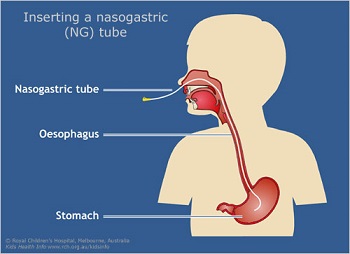Where Does a Nasal Feeding Tube Go
A nasogastric (nay-zo-gas-tric) tube (NGT) is a thin, soft tube that is passed through your child's nostril, down the back of their throat, through the oesophagus (food pipe) and into their stomach.

Inserting the tube is usually a short procedure, and the tube will go down easily if your child is relaxed. There are ways you can help your child to remain calm, including distraction and relaxation techniques.
Why does my child need an NGT?
Generally, a child will be given an NGT so that specially prepared liquid food or fluids can be passed down the tube. The reasons your child might need an NGT for feeding include:
- problems with sucking and swallowing
- dehydration from vomiting/diarrhoea and not drinking enough
- not getting enough nutrition through their normal diet
- they cannot swallow the medications they need.
Sometimes, an NGT may be used to empty a child's stomach contents, including stomach gases.
What to expect
Even though having an NGT put in is a short procedure and does not hurt, it is not very pleasant. Paracetamol or other medicines for pain relief will not stop the discomfort. Knowing what will happen during the procedure will help make it easier for you and your child. The following tips may help both you and your child manage the procedure better:
- If your child is a baby, a dummy with sucrose (a liquid form of sugar) and swaddling them in a blanket may give them comfort and help them feel secure.
- Try to distract your child by talking about favourite activities or friends. In young children, cuddling a soft toy or watching a favourite TV show may be useful.
- Offering your baby a bottle to suck or asking your child to swallow while the tube is passing may help it go down more easily.
For more tips, see our fact sheet Reducing your child's discomfort during procedures.
Once it has been inserted, the NGT is usually held in place by being gently taped to the side of your child's face, near the nostril.
Care at home
The most important aspect of caring for an NGT at home is checking that it is in the correct position (i.e. sitting in the stomach) before you put anything down it. Your treating team will teach you how to do this.
- Your child may initially complain of a sore throat. The sore throat is usually mild and gets better with time.
- If there are no other reasons why your child cannot eat or drink (e.g. they have a problem with swallowing), then your child can eat and drink with the tube in place. This might be the case if they have the NGT for medicines only. Check with your child's doctor whether your child is allowed to eat and drink first.
- Babies and children who need the tube for a long period may need to have it replaced from time to time. This normally means your child will have to return to hospital. It is not safe to try to reinsert an NGT yourself if you have not been trained to do it.
- If your child is going home with an NGT, you need to have a clear plan in place before leaving the hospital. This plan should include who to contact and what to do if the tube comes out.
- Any adult caring for your child will need to be educated about how to care for the tube and how to use the NGT to feed your child. Ask nursing staff for more information.
Key points to remember
- A nasogastric tube (NGT) is a soft tube that is placed through your child's nostril, down the back of the throat, through the oesophagus and into the stomach.
- Paracetamol and other pain medications will not relieve the discomfort of tube insertion. However, the use of swaddling, distraction, relaxation techniques and sucking or swallowing may help your child.
- The most important aspect of caring for an NGT at home is checking that it is in the correct position.
- It is important to know what to do if the NGT falls out. Do not try to insert the tube yourself without proper training.
For more information
- Kids Health Info fact sheet: Reducing your child's discomfort during procedures
- RCH@Home manual: Nasogastric Tube and Nasojejunal Tube Management
Common questions our doctors are asked
How can I stop my baby from trying to pull the NGT out?
The NGT will be firmly secured with tape, to the side of your child's face, to reduce the risk of them pulling it out. It can be secured behind their neck so that it doesn't dangle in front of them. Occasionally, children will have mittens put on, so that they can't grab at the tube and risk dislodging it.
If my child needs to have an NGT for a long time, are there any risks or side effects I should know about?
Some children with long-term NGTs can develop an aversion to eating food and drinking fluids orally. Your child can work with a speech therapist to relearn these skills and ensure safe, enjoyable eating and drinking.
Another side effect can be rash or irritation due to the tape holding the NGT in place. Talk to the medical or nursing staff if this happens. There are several things that can be done to avoid this rash or irritation, including the use of a steroid cream, using an adhesive remover when removing the tape, and swapping the side the tape is on.
Developed by The Royal Children's Hospital General Paediatrics department. We acknowledge the input of RCH consumers and carers.
Reviewed May 2018.
Kids Health Info is supported by The Royal Children's Hospital Foundation. To donate, visit www.rchfoundation.org.au.
Source: https://www.rch.org.au/kidsinfo/fact_sheets/Nasogastric_tubes/
0 Response to "Where Does a Nasal Feeding Tube Go"
Post a Comment